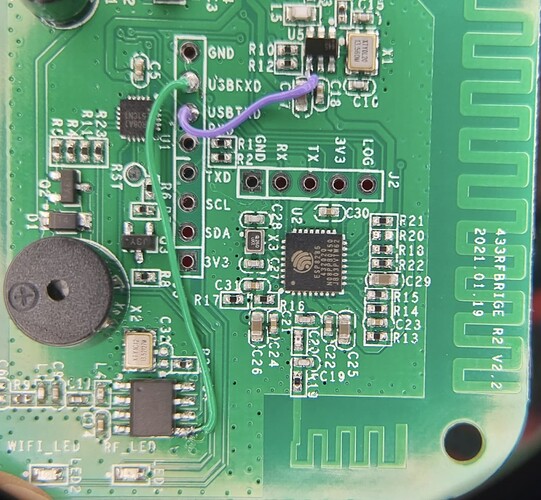New direct hack
It is the equivalent of Hardware Itead Sonoff RF Bridge Direct Hack to get super wide protocol support, but for the new R2 v2.2 board (not a way to flash Portisch.)
Tutorial
1. Cut the usb data lines
Exactly as in the original mod for older versions, these traces are connected with GPIOs we’ll use to connect the receiver and transmitter directly to the ESP8285. If left conected, usb chargers may bridge them and nothing will work (or worse).
2. Connect the transmitter
USBTXD → pin 4 of the 6-legged chip (purple cable, bottom left pin in the image)
3. Connect the receiver
USBRXD → pin 5 of the 8 legged chip near the LEDs (green cable, bottom right pin in the image)
ESPHome configuration
esphome:
name: sonoff-rf
platform: ESP8266
board: esp8285
build_path: ./build/sonoff-rf
wifi:
ssid: !secret wifi_name
password: !secret wifi_pass
fast_connect: true
api:
logger:
ota:
web_server:
status_led:
pin:
number: GPIO13
inverted: yes
# USBRX = GPIO4 ---> receiver
# USBTX = GPIO5 ---> trasmitter
# receiver = pin 5 of the 8-legged chip (the one closer to the wifi antenna)
# transmitter = pin 4 of the 6-legged chip (closest to r12)
remote_receiver:
pin: GPIO04
dump: all
remote_transmitter:
pin: GPIO05
carrier_duty_percent: 100%
# this will log received commands, and can also transmit. Read up here:
# https://esphome.io/components/remote_transmitter.html#remote-setting-up-rf
Notes
In this mod, the existing encoder/decoder chip is not disconnected from either the transmitter nor the receiver. From what I could measure, this revision of the board has a 1k resistor between the encoder chip and the modulator, so the ESP “wins” anyway. It works perfectly fine for me, but do at your own risk.
Update: The tracks to cut were found below, make sure to do that also

